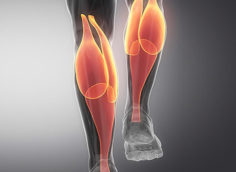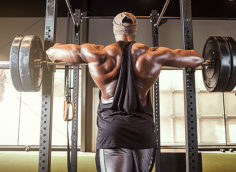Here's what you need to know...
- "Broscience" refers to the anecdotal reports of jacked dudes at the gym. It's the antithesis of scientific research. However, science doesn't always trump under-the-bar experience.
- Don't get the 19-year olds spouting broscience mixed up with battle-scarred lifters who form their opinions based on evidence peer-reviewed by PRs and first place trophies.
- A coach with 30 years of experience under the bar and 20 years spent training a variety of athletes for competition beats the textbook thumper with a handful of studies and no gym membership.
- Never disregard science, but remember that research can often be wrong. The hard-won wisdom of a successful, experienced coach seldom is.

You see them in every gym. Usually a pack of young guys standing around a bench yelling "It's all you, bro!" as one of them upright rows half the weight his straining bro thinks he's pressing. After twelve minutes of standing around texting, taking selfies, and planning their next chest/biceps day, another guy straddles the bench. It's in this environment that you're likely to overhear some broscience.
If you're not hip to the lingo, here's how Urban Dictionary originally defined it:
Broscience is the predominant brand of reasoning in bodybuilding circles where the anecdotal reports of jacked dudes are considered more credible than scientific research.
It was a word that hardcore lifters could get behind. We're smart. We use a blend of good science and real world experience to further our progress. We don't need frat-boy facts and meathead mythology. Heck, we've read the studies.
But now things are changing. Offer any tidbit of hard-won wisdom based on your training experience and someone (usually on the internet) will retaliate with a spittle-flecked accusation of "BROOOOSCIENCE!" Accordingly, Urban Dictionary has added another definition of the term:
A sarcastic term implying that the time-tested, muscle-building wealth of knowledge developed and utilized by successful, experienced bodybuilders is inferior to the continually shifting hypotheses of articulate, textbook-savvy 155-pound chemists with little or no real world first-person experience to substantiate their conclusions. The term "broscience" is oft repeated on bodybuilding and fitness oriented internet forums in an attempt to demonstrate online dominance as a substitution for success in the arena of actual bodybuilding.
Ouch. The pendulum seems to have swung. And maybe for good reason.

In the heyday of what many consider the Golden Age of bodybuilding, the 60's and 70's, you learned about training mainly through word of mouth. Sure, there were magazines, but these were filled with anecdotal reports of how the big guys at the time trained. Back then, if you wanted big biceps, you walked up to the guy stretching his sleeves and said, "How do you work arms?" Bodybuilding wisdom was passed from person to person for decades. If something didn't work, it was removed from the oral literature, a sort of bodybuilding version of natural selection.
Not all of this advice was accurate of course. And sometimes the training methods worked but not for the reasons they thought. Genetics always plays a role in what works from individual to individual, and drugs started to muddy the waters after 1960 or so, but the chaff was usually separated from the wheat. All our heroes, from Arnold to Zane to Ferrigno were, in fact, broscientists by today's more derisive definition. But guess what? They were muscular and strong anyway. (And if you're already having a tantrum about steroids, then replace Arnold's name with your favorite pre-1960's bodybuilder.)
Science, the studies, and the sacred literature certainly have their place. Science tells us why something works or doesn't work, or at least narrows the conclusion. But often, science – when it comes to training at least – comes along after the fact. The studies often only serve the purpose of telling us that the meatheads were right. Show the latest study that proves that multiple sets are better than single sets for hypertrophy to an experienced lifter or coach and he'll nod his head and say, "Interesting. Thanks." If he's a smartass he'll say, "No fucking shit."
Also, the science is sometimes (gasp!) wrong, or at least biased or based on a faulty premise. The myth that squats are bad for your knees was brought to you by science. Bad science, but nonetheless, science. The myth arose in the 1950's and was based solely on one flawed study. A researcher, Dr. Carl Klein, was hell-bent on proving that deep knee bends (squats) were destructive to the knees, so he conducted a study with 100 lifters and 100 non-lifters. He put an apparatus onto the knee and pushed laterally to see if it would move.
Pushing from the side like this showed ligament laxity. The problem with the study was that, before the subject got on the table, Dr. Klein would ask him whether or not he was a lifter. If the subject said yes, the good doctor would press harder on the apparatus. The results were flawed because of the researcher's bias and have never been repeated in subsequent studies. But the damaging data was out there: people were told that "squats were bad" and they still spread this myth today – 60 years later.
It's just one example, and not all science is so wrought with bias. But perhaps all those studies on untrained college kids using light-weight leg extensions aren't the best way to determine how strong guys should squat. (Mark Rippetoe further dissects this topic here.) Still, some punk sitting behind the safety of his keyboard will fling a study like that at a 600 pound squatter. Something is off here.

A coach with 30 years of experience under the bar and 20 years spent training a variety of athletes for competition beats the textbook thumper with a handful of studies and no gym membership.
The password here is competition. Competition is the ultimate bullshit-removal device. You can't always rely on the latest study because it could be wrong, or it could've been poorly conducted using a population that doesn't apply. You have to go by what's been proven in the weight room to work after years of trial and error. If something doesn't work, real coaches and athletes abandon it quickly. Because if they don't, they lose. After 125 years of modern barbell training, the callused and bloodied "un-credentialed field scientists" we call coaches and bodybuilders have figured a few things out.
Most effective coaches will come right out and say it: "I don't know exactly why this works, but it does. It worked for me and it works for my athletes and clients. If they don't do it, they don't get results. If they do it, they get great results." He'd be interested to know exactly why it works, but he doesn't have to know to continue to get the effect he wants.
Science often does inform us, but mainly by figuring out which part of broscience is working and why. Bodybuilders know that training for the pump works. Back in Arnold's day, they didn't know exactly why and may have used some incorrect broscience-y statements to explain it. They may have been wrong about the mechanisms, but they were not wrong about the effects. Good science will tell us exactly why something works, and that's good to know. But it doesn't effect the results. Knowing the exact micro-details of why something works is cool, but it worked before we knew those details. In short, the bros figured it out first.
Science can be used to double-check and verify. Sometimes it can be used to elicit new ideas and training methodology, but then these methods must be put to the test under the iron. This should be the real definition of "peer reviewed". If it passes, great. If it fails, it should be disregarded, no matter how glossy the journal from whence it came. Science is often wrong; the guy with 30 years of experience seldom is.

Maybe you're right to take the training advice of a steroid-using Samoan with a grain of salt. But that same salt must also be sprinkled liberally over the latest exercise study. And who's most critical of these studies? The study-flingers themselves. People who demand, "Show me the studies!" will seldom be convinced by the studies you show them. They'll pick them apart if they're bored enough and "prove" you wrong. So, even the study-flingers don't believe most of the studies, at least not the ones that go against their own pre-existing bias or their own cherry-picked abstracts. Go watch the action of two studybuilders on a forum. They use different studies – or even the same studies – to e-fight with the other guy. Actually, don't do that. It's incredibly boring and you could be in the gym figuring it out for yourself or listening to someone with real-world experience.
So who do you believe? An experienced coach whose job depends on the results he gets, or the guy with a handful of studies whose income isn't affected by whether or not something works? Do you go with the advice of the guy who benches 500 raw or do you go with the latest studies conducted by people who often don't bench press at all? Well, ideally, you seek out the research conducted by people who lift and have a reputation they want to protect in the strength-training community. (Some of best can be found right here on T Nation, by the way.)
The lesson? When you hear about a new training technique, go the gym and try it for a fair amount of time instead of going to the library to look for the studies. The science guys will figure it out eventually, but you'll probably beat them to the punch. Trust the advice of the proven coach with years of experience before trusting the latest paper. Do not disregard the science. It's handy when you want to know exactly why something works. Then you can say, "Oh, okay. Well, cool!" and get back to training. Chalk-caked hands, more often than not, trump paper-cut fingers.
But mainly, the lesson here is that "broscience" has become an abused, misapplied term. Don't get the 19-year old frat boys mixed up with battle-scarred lifters and coaches who form their opinions based on evidence peer-reviewed by PRs and first place trophies.
Perhaps Jim Wendler said it best: "All you have to do look at someone's shins and hands. Do they look fucked up? Then listen to them."





